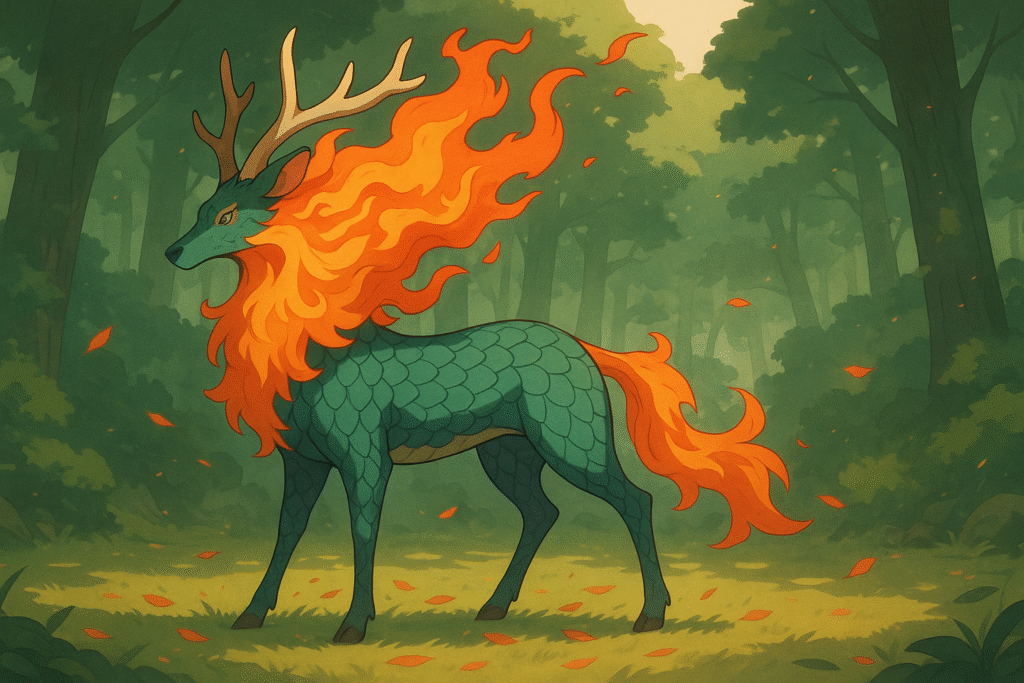Have you ever wondered about the majestic creature behind the famous Japanese beer brand? The kirin Japanese (麒麟, きりん) is far more than just a corporate logo—it’s one of the most revered mythological beings in Japanese folklore, embodying virtues of wisdom, prosperity, and peace. Today, we’ll explore this fascinating creature that has captivated Japanese imagination for centuries.
What Is a Kirin Japanese? Understanding the Sacred Beast
The kirin Japanese is considered the most sacred and powerful of all mythical creatures in Japan, even surpassing the famous dragon (tatsu) and the phoenix (hōō) in its divine status. Often misunderstood as simply the “Japanese unicorn,” the kirin actually possesses a much more complex and awe-inspiring form.
This majestic being combines features of multiple animals:
- A deer-like body covered in dragon scales
- A flowing, fiery mane reminiscent of dancing flames
- An ox-like tail
- One or two horns (depending on regional variations)
- A face radiating serene wisdom
Did you know? The Japanese word “kirin” (麒麟) is also used for giraffes in modern Japanese, as early Japanese people thought the tall African animals resembled their mythical kirin when first encountered!
Origins of the Kirin Japanese: Chinese Influences
The kirin didn’t originate in Japan but was adopted from Chinese mythology, where it’s known as the “qilin” (also written as 麒麟). Like many elements of Japanese culture, this mythological creature crossed over from mainland Asia, evolving distinct Japanese characteristics over time.
In Japanese folklore, the kirin developed a stronger association with:
- Fire elements (its mane often depicted as flames)
- Divine judgment
- Connections to imperial power
- Gentler temperament than its Chinese counterpart
Symbolic Meaning: What Does the Kirin Japanese Represent?
The kirin Japanese appears only during times of peace and prosperity or to herald the arrival of a great and benevolent ruler. Its appearance is considered an extremely auspicious omen in Japanese culture.
Key Symbolic Attributes:
Peace and Harmony: The kirin is so gentle it refuses to step on even a single blade of grass or harm any living creature.
Justice and Wisdom: Despite its gentle nature, the kirin Japanese is quick to punish the wicked, breathing sacred fire to eliminate evil.
Pure Vegetarianism: Unlike many mythical beasts, the kirin never consumes flesh, highlighting its spiritual purity.
Divine Protection: Having a kirin’s image is believed to ward off misfortune and bring blessings.
As our JLPT N5 Study Guide explains, understanding these cultural symbols can significantly enhance your appreciation of Japanese language and culture beyond basic vocabulary and grammar patterns.
The Kirin Japanese in Art and Culture
The kirin’s influence extends far beyond ancient legends, permeating modern Japanese culture in numerous ways:
Traditional Art
In traditional Japanese artwork, the kirin is often depicted alongside other divine creatures like the dragon, phoenix, and tortoise. You’ll find kirin carvings and paintings adorning:
- Shinto shrines and Buddhist temples
- Imperial palaces
- Traditional architectural elements
- Family crests of noble houses
Want to explore Japan’s culture?
Discover Japan’s rich culture, traditions, and hidden gems with our expertly crafted guides. Get insider tips on travel, food, and history. All for free!
Modern References
Today, the kirin Japanese appears in:
- The famous Kirin beer logo and branding
- Anime and manga (like “Monster Hunter” and various fantasy series)
- Video games featuring Japanese mythological creatures
- Company names and logos symbolizing prosperity
If you’ve explored other Japanese yokai (supernatural creatures) like the Hakutaku or the Baku, you’ll notice the kirin shares their divine status while standing apart in its supreme reverence.
Kirin vs. Other Mythical Creatures
What makes the kirin Japanese special compared to other legendary beings?
| Feature | Kirin Japanese | Western Unicorn | Chinese Dragon |
|---|---|---|---|
| Appearance | Deer-like with scales and fire | Horse with a horn | Serpentine with scales |
| Temperament | Gentle but punishes evil | Gentle and pure | Powerful and imperial |
| Symbolism | Peace, wisdom, prosperity | Purity, grace | Power, prosperity |
| Cultural Status | Most sacred beast | Magical creature | Imperial symbol |
How to Pronounce “Kirin” in Japanese
For Japanese language learners, the pronunciation is straightforward:
- Ki (きー): Similar to “key” in English
- Rin (りん): Like “reen” with a rolled ‘r’ sound
In Japanese: 麒麟 (きりん) – kirin
Q&A: Common Questions About the Kirin Japanese
Q: Is the kirin Japanese the same as a unicorn?
A: No. While both are horned mythical creatures, the kirin Japanese has a deer-like body with scales, a fiery mane, and represents different cultural values than the Western unicorn.
Q: Why is Japanese beer named “Kirin”?
A: Kirin Brewery chose this name to associate their product with the auspicious, divine qualities of the mythical creature, symbolizing good fortune and excellence.
Q: How is the kirin different from its Chinese counterpart?
A: The Japanese kirin evolved to have stronger associations with fire, gentleness, and divine judgment, while maintaining its core symbolic meaning of peace and prosperity.
Q: Does the kirin appear in other Asian cultures?
A: Yes, variants of this creature appear throughout East Asia, including Korea (where it’s known as the “girin”) and Vietnam (as the “ky lan”).
The kirin Japanese is much more than a mythical creature—it’s a symbol of Japan’s highest ideals of peace, wisdom, and divine protection.
If you’re fascinated by Japanese mythology and want to deepen your understanding of the language and culture, check out our comprehensive JLPT N5 Study Guide that connects language learning with cultural context.
Have you encountered the kirin in other aspects of Japanese culture? Share your experiences in the comments below!
Love Japan? Stay in the Loop!
Get the best of Japan straight to your inbox: language, culture & travel insights!




